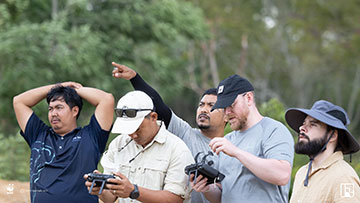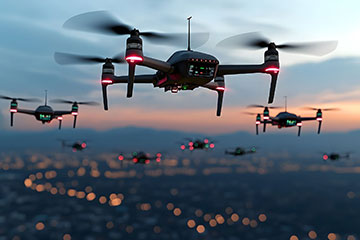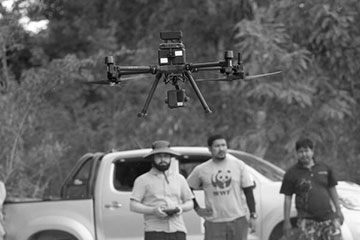
Richard Geipel (second from right) in the field collaborating with the WWF. [Image: WWF Denmark]
The July/August 2025 issue of Optics & Photonics News featured the magazine’s biennial feature spotlighting 10 Entrepreneurs to Watch. Here, we offer an interview with one of those entrepreneurs, Kenneth Richard Geipel, cofounder and CCO of Robotto. Robotto leverages advanced perception robotics with autonomous drones to detect and track wildfires, wildlife and other diverse applications.
Can you summarize what Robotto is doing and your future directions?
We are a spinoff from our bachelor’s thesis in robotics, where we developed this new framework on how to use artificial intelligence (AI) on drones and how to calculate objects in space. Our first use case was for wildfires. We found that the firefighters, whenever they go out to a new wildfire, they need to first get intel on what's going on—so where the fire is, how big is it, where is it moving and all of that—before they can act. And that just allows more time for this fire to develop and to become uncontrollable.
For our first product, we combined the drones with AI running at an edge level, meaning that all data are just processed on the drone, making them capable of being fully autonomous. So we sent them out to locate the fire, calculate where and how big it is, calculate the wind speed and direction, all in real time for the firefighters, so they would be able to instantly act when they reached the fire and contain it much faster.
Then COVID hit. We don’t have wildfires in Denmark, and we couldn't go anywhere. But we knew we wanted to use this technology for good, so we coupled with the World Wildlife Fund for Nature, and together we were able to do work across the globe, calculating or counting different types of animals. We are looking at elephants in Thailand and koalas in Australia.
And then, given the new situation and war here in Europe, we are moving more and more into the security space.
How did Robotto develop from your bachelor’s thesis?
We're just a couple of nerds who buried ourselves behind computer screens and played with these robots, drones. When we first got this idea, we knew that we wanted to work with AI drones because we didn't really get to touch on that during our formal education.

A Robotto drone. [Image: Courtesy of Robotto]
Our university, Aalborg University, Denmark, established a collaboration with the Danish Emergency Management Agency (DEMA), and they offered an opportunity for us to do something together. That’s when DEMA told us about this really big problem with wildfires.
At the time, if I'm being totally honest, we had been considering using our technology to develop a pizza-delivery drone because we were tired of walking down to the pizza place. But we decided to take ourselves seriously and work on the wildfire project.
During that process, there were a bunch of different problems within computer vision and within edge processing that we needed to solve. First, we had to figure out how to make AI run on these tiny processors—usually these AI models take a lot of memory, and there's not a lot of that on these processors. Then after that, we had to figure out how the drone would actually recognize the fires, and how we could calculate where the fire is without damaging the drone.
We just started this as a bare-bones thing and didn’t really think of it as a product in that sense. But when enough people came up to us and expressed interest in providing financial support, we start to believe in ourselves.
After we did all of that, one day our professor came to us and said, if we were interested, he thought we could actually publish a couple of scientific papers on what we’d done. This was a huge surprise to us because this was at a bachelor’s level and we felt like we were just fooling around.
But we decided to go for it, and after we published, we got invited to a lot of different conferences through the university. And then during those conferences, private investors came up to us and said that if we were willing to take this to the next level, then they were willing to back us financially. At first, we didn't really want to do that. We just started this as a bare-bones thing and didn’t really think of it as a product in that sense. But when enough people came up to us and expressed interest in providing financial support, we start to believe in ourselves. Then we launched Robotto.
Did your time in the armed forces play a part in your career?

The WWF Denmark and Thailand work with Robotto to track and protect endangered elephants in Thailand. [Image: WWF/Katanyu Wuttichaitanakor]
The reason I started to study robotics was because I had just done 10 years in the Danish armed forces, and I had three deployments to Afghanistan. I was tired of war and wanted to do something completely different.
But I think that we are more pragmatic. We just wanted to enable this technology to solve real, big problems. And what we see here in Europe right now is, obviously a very big problem—Russia knocking on the door. Even here in Denmark, we’re seeing issues, like with the cables being cut in the Baltic Sea. So we're trying to push this technology in the security space to really augment what's already being done by people there.
Are there any projects that you found to be especially exciting or impactful?
I love everything that we do with wildlife because it lets us go into remote places, for example, the Thailand jungle. It's great getting to learn about all of these different cultures; how they work and their view on wildlife and on climate change—things like that.
And then getting to be totally out there in nature using high-tech robotics—I think it’s super cool. Flying these drones with AI out in the wilderness feels so surreal in some ways, and it gives me so much fulfillment. We’re just a couple of nerds from Denmark really going way out there in the world with this cool product we made.

